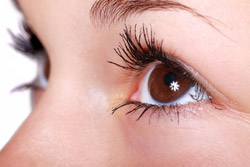Introduction
Bacteria, dirt and other foreign particles on the face can sometimes pass through the eyelids and come into contact with the eye’s surface. Everyday dirt from a garden, soiled clothing or a kitchen bench often contain chemicals and bacteria, and there are many ways in which these substances can enter the eye while an individual is working or relaxing. Exposure of the eyes’ surface to these foreign substances can lead to irritation or infection. However, preventing exposure to these substances or preventing the eyes from becoming damaged as a result of such exposure is simple and can be achieved largely through keeping the face clean.
Eye disorders associated with facial hygiene

Swelling or inflammation of the eye area
Foreign particles (e.g. from a dirty face) occasionally enter the eyelids and contact the eye’s surface. Such particles may cause irritation, redness or inflammation of the eye.
Trachoma is an eye disorder characterised by infection of the conjunctiva by Chlamydia trachomatis. It is the world’s leading cause of blindness and is associated with poor sanitation and hygiene, overcrowding and poverty. Poor facial hygiene also facilitates the spread of the infection.
Trachoma mainly affects children in the third world but is also common amongst Indigenous Australians. Australia is the only developed country still affected by trachoma and in some Indigenous communities, trachoma prevalence is as high as 50%. The infection is spread through direct or indirect (e.g. touching, contaminated bedding, flies) contact with infected eye, nose and throat secretions.
Preventative measures
There are a range of measures which can be taken to protect the eyes from exposure to facial dirt and bacteria.

Washing and removing objects from the eyes
Keeping the face clean promotes eye cleanliness, however in some situations the eyes themselves will require cleaning, or foreign objects will need to be removed from eyes. It is important that individuals ensure they wash their hands thoroughly before washing or removing a foreign object from their eye, or another person’s eye (e.g. a child’s eye).
In order to prevent the introduction of bacteria, parents should wash their child’s eyes if they appear dirty or sticky. Boiled water which has cooled to body temperature should be used. Normal bath water should not be used as it will contain bacteria from the child’s body.
Parents should wash their hands before cleaning a child’s eye and use a fresh cotton wool swab each time they wipe an eye. The cotton wool should be dipped in the cooled, boiled water and squeezed to remove excess water. It should then be used to wipe the child’s eye gently, starting at the nose and working outwards. If the child’s eye remains sticky, the parent should take a fresh piece of cotton wool and repeat the cleaning process.
Removing foreign objects from eyes
Small foreign objects which enter the eye are often removed by the eye’s natural cleaning mechanisms of tears and blinking. However, in some cases blinking and tears will not remove a foreign object and human intervention may be needed. If children needs help removing a foreign object from the eye, parents should:
- Wash their hands thoroughly before assisting the child;
- Examine the eye in a well lit area, by asking the child to look up, down, left and right. This will usually enable the parent to see the foreign object;
- Rinse the eye with a gentle flow of water to try and dislodge the foreign object;
- If rinsing fails, a clean cotton tip can be used to remove objects stuck on the eyelids, but the cotton tip should not come into contact with the eye’s surface.

If a chemical substance enters the eyes parents should flush the eye with tap water or saline solution immediately. Once the eye is flushed, emergency medical treatment should be sought.
Antibiotic treatment to prevent trachoma progression
Early treatment of trachoma with antibiotics is effective in preventing progression of the disease and alleviating symptoms such as vision loss and eye irritation. Antibiotics can be administered either orally or topically. However, it is important to note that antibiotic treatment can only cure existing infection and is not a strategy which can control transmission of new infections.
Improving sanitation and environmental conditions
The health of an individual’s environment also affects their health, and many diseases are associated with poor environmental conditions such as lack of water and sanitation. These conditions are characteristic of remote Indigenous communities in Australia, where trachoma infection remains rife.
Trachoma is one disease which is associated with inadequate environmental health (such as overcrowding and poor sanitation). Numerous environmental improvement interventions have been implemented in developing countries in an attempt to prevent trachoma infection. These include the provision of water and sanitation facilities (in particular pit latrines to control fly populations) and insecticide spraying to eradicate infection carrying flies.
There is some evidence that insecticide spraying can reduce active trachoma, Studies also suggest that broad environmental health interventions (e.g. combined provision of pit latrines and clean water alongside insecticide spraying) can reduce trachoma prevalence.
References
- United States Food and Drug Authority. Eye cosmetics and eyebrow/eyelash dyes. 2001. [cited 2010, October 15]. [URL Link]
- Solomon AW, Mabey DCW. Trachoma. BMJ Clin Ev. 2007; 11: 706-18. [Abstract | Full Text]
- National Institute of Health. Eye Emergencies. 2009 [cited 2010, October 15]. [URL Link]
- Victorian Government Health Department. Trachoma. 2009. [cited 2010, October 15]. [URL Link]
- Ejere H, Alhassan MB, Rabiu M, Face washing promotion for preventing active trachoma. Cochrane Database Syst Rev. 2004; 3: CD003659. [Full Text]
- Kuper H, Solomon AW, Buchan J, et al A critical review of the SAFE strategy for the prevention of blinding trachoma. Lancet Infect Dis. 2003; 3: 372-81. [Abstract]
- National Health Service. Eye cleaning for newborns. 2006. [cited 2010, October 15]. [URL Link]
- Emerson PM, Cairncross S, Bailey RL, Mabey DCW. Review of the evidence base for the F and E components of the SAFE strategy for trachoma control. Trop Med Int Health. 2000; 5(8): 515-27. [Abstract]
- Khandekar R, Thanin TTK, Thi PD, Impact of face washing and environmental improvement on reduction of active trachoma in Vietnam: a trachoma intervention study. Ophthalmic Epidemiol. 2006; 13(1): 43-52. [Abstract]
All content and media on the HealthEngine Blog is created and published online for informational purposes only. It is not intended to be a substitute for professional medical advice and should not be relied on as health or personal advice. Always seek the guidance of your doctor or other qualified health professional with any questions you may have regarding your health or a medical condition. Never disregard the advice of a medical professional, or delay in seeking it because of something you have read on this Website. If you think you may have a medical emergency, call your doctor, go to the nearest hospital emergency department, or call the emergency services immediately.








